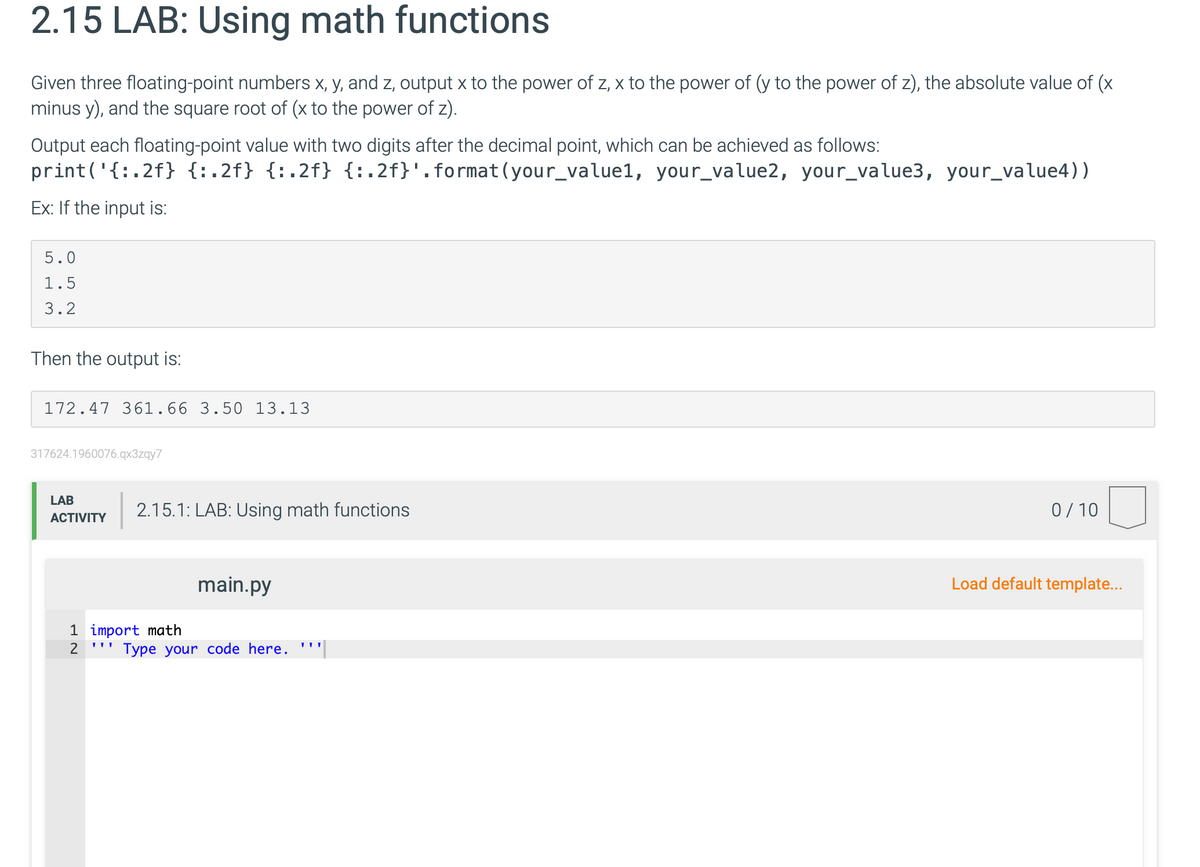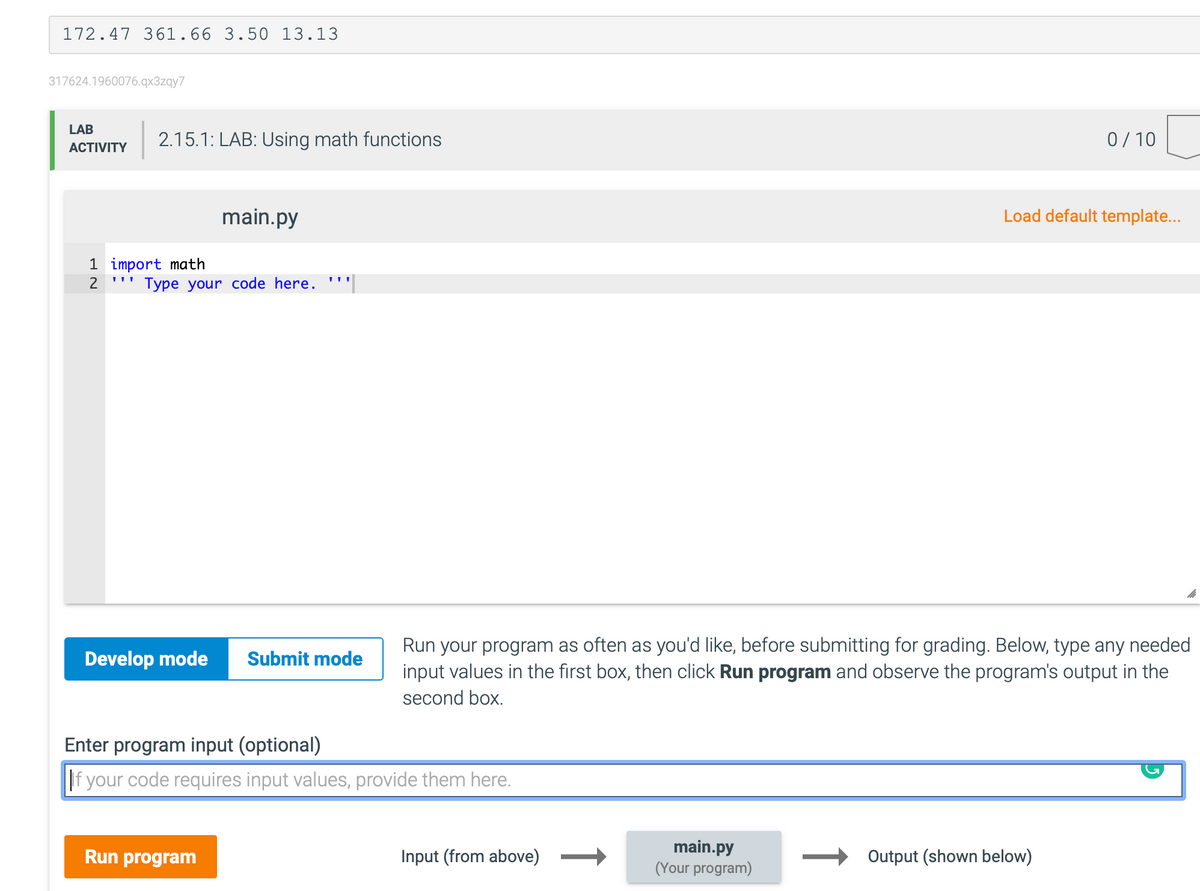2.15 LAB: Using math functions Given three floating-point numbers x, y, and z, output x to the power of z, x to the power of (y to the power of z), the absolute value of (x minus y), and the square root of (x to the power of z). Output each floating-point value with two digits after the decimal point, which can be achieved as follows: print('{:.2f} {:.2f} {:.2f} {:.2f}'.format(your_value1, your_value2, your_value3, your_value4)) Ex: If the input is: 5.0 1.5 3.2 Then the output is: 172.47 361.66 3.50 13.13 317624.1960076.qx3zqy7 LAB 2.15.1: LAB: Using math functions 0/ 10 ACTIVITY main.py Load default template... 1 import math Type your code here. ''|
2.15 LAB: Using math functions Given three floating-point numbers x, y, and z, output x to the power of z, x to the power of (y to the power of z), the absolute value of (x minus y), and the square root of (x to the power of z). Output each floating-point value with two digits after the decimal point, which can be achieved as follows: print('{:.2f} {:.2f} {:.2f} {:.2f}'.format(your_value1, your_value2, your_value3, your_value4)) Ex: If the input is: 5.0 1.5 3.2 Then the output is: 172.47 361.66 3.50 13.13 317624.1960076.qx3zqy7 LAB 2.15.1: LAB: Using math functions 0/ 10 ACTIVITY main.py Load default template... 1 import math Type your code here. ''|
C++ Programming: From Problem Analysis to Program Design
8th Edition
ISBN:9781337102087
Author:D. S. Malik
Publisher:D. S. Malik
Chapter6: User-defined Functions
Section: Chapter Questions
Problem 12SA
Related questions
Question
Python

Transcribed Image Text:2.15 LAB: Using math functions
Given three floating-point numbers x, y, and z, output x to the power of z, x to the power of (y to the power of z), the absolute value of (x
minus y), and the square root of (x to the power of z).
Output each floating-point value with two digits after the decimal point, which can be achieved as follows:
print('{:.2f} {:.2f} {:.2f} {:.2f}'.format(your_value1, your_value2, your_value3, your_value4))
Ex: If the input is:
5.0
1.5
3.2
Then the output is:
172.47 361.66 3.50 13.13
317624.1960076.qx3zqy7
LAB
2.15.1: LAB: Using math functions
0/ 10
АCTIVITY
main.py
Load default template...
1 import math
2 ''' Type your code here. '''|

Transcribed Image Text:172.47 361.66 3.50 13.13
317624.1960076.qx3zqy7
LAB
2.15.1: LAB: Using math functions
0/10
ACTIVITY
main.py
Load default template...
1 import math
2
Type your code here. ''"
Run your program as often as you'd like, before submitting for grading. Below, type any needed
input values in the first box, then click Run program and observe the program's output in the
Develop mode
Submit mode
second box.
Enter program input (optional)
If your code requires input values, provide them here.
main.py
(Your program)
Run program
Input (from above)
Output (shown below)
↑
↑
Expert Solution
This question has been solved!
Explore an expertly crafted, step-by-step solution for a thorough understanding of key concepts.
This is a popular solution!
Trending now
This is a popular solution!
Step by step
Solved in 4 steps with 3 images

Knowledge Booster
Learn more about
Need a deep-dive on the concept behind this application? Look no further. Learn more about this topic, computer-science and related others by exploring similar questions and additional content below.Recommended textbooks for you

C++ Programming: From Problem Analysis to Program…
Computer Science
ISBN:
9781337102087
Author:
D. S. Malik
Publisher:
Cengage Learning

C++ Programming: From Problem Analysis to Program…
Computer Science
ISBN:
9781337102087
Author:
D. S. Malik
Publisher:
Cengage Learning